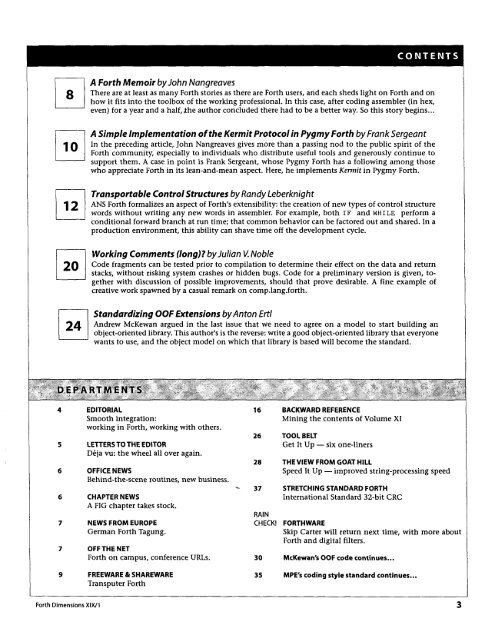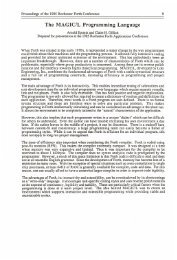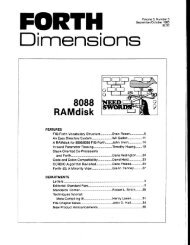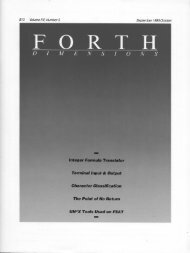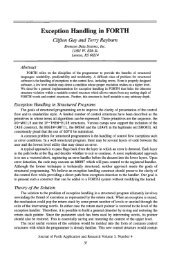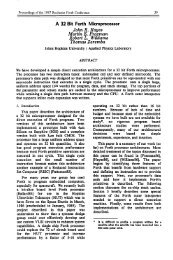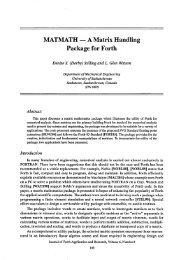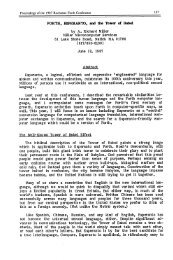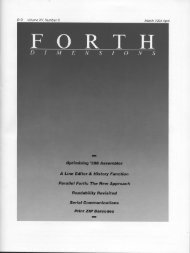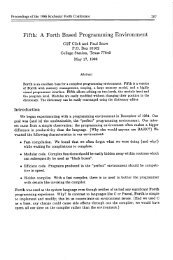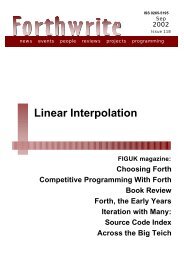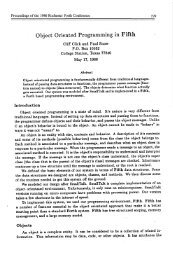1 - Forth Interest Group
1 - Forth Interest Group
1 - Forth Interest Group
Create successful ePaper yourself
Turn your PDF publications into a flip-book with our unique Google optimized e-Paper software.
A <strong>Forth</strong> Memoir by John Nangreaves<br />
There are at least as many <strong>Forth</strong> stories as there are <strong>Forth</strong> users, and each sheds light on <strong>Forth</strong> and on<br />
how it fits into the toolbox of the working professional. In this case, after coding assembler (in hex,<br />
even) for a year and a half, the author concluded there had to be a better way. So this story begins ...<br />
A Simple Implementation of the Kermit Protocol in Pygmy <strong>Forth</strong> by Frank Sergeant<br />
In the preceding article, John Nangreaves gives more than a passing nod to the public spirit of the<br />
<strong>Forth</strong> community, especially to individuals who distribute useful tools and generously continue to<br />
support them. A case in point is Frank Sergeant, whose Pygmy <strong>Forth</strong> has a following among those<br />
who appreciate <strong>Forth</strong> in its lean-and-mean aspect. Here, he implements Kermit in Pygmy <strong>Forth</strong>.<br />
Transportable Control Structures by Randy Leberknight<br />
ANS <strong>Forth</strong> formalizes an aspect of <strong>Forth</strong>'s extensibility: the creation of new types of control structure<br />
words without writing any new words in assembler. For example, both IF and WHILE perform a<br />
conditional forward branch at run time; that common behavior can be factored out and shared. In a<br />
production environment, this ability can shave time off the development cycle.<br />
Working Comments (long) by Julian V. Noble<br />
Code fragments can be tested prior to compilation to determine their effect on the data and return<br />
stacks, without risking system crashes or hidden bugs. Code for a preliminary version is given, together<br />
with discussion of possible improvements, should that prove desirable. A fine example of<br />
creative work spawned by a casual remark on comp.lang.forth.<br />
Standardizing OOF Extensions by Anton Ertl<br />
Andrew McKewan argued in the last issue that we need to agree on a model to start building an<br />
object-oriented library. This author's is the reverse: write a good object-oriented library that everyone<br />
wants to use, and the object model on which that library is based will become the standard.<br />
, DEPARTMENTS<br />
. .<br />
A<br />
A<br />
4 EDITORIAL<br />
Smooth integration:<br />
working in <strong>Forth</strong>, working with others.<br />
5 LETTERS TO THE EDITOR<br />
Deja vu: the wheel all over again.<br />
6 OFFICE NEWS<br />
Behind-the-scene routines, new business.<br />
6 CHAPTER NEWS<br />
A FIG chapter takes stock.<br />
7 NEWS FROM EUROPE<br />
German <strong>Forth</strong> Tagung.<br />
7 OFF THE NET<br />
<strong>Forth</strong> on campus, conference URLs.<br />
%<br />
16 BACKWARD REFERENCE<br />
Mining the contents of Volume XI<br />
26 TOOL BELT<br />
Get It Up - six one-liners<br />
28 THE VIEW FROM GOAT HILL<br />
Speed It Up - improved string-processing speed<br />
37 STRETCHING STANDARD FORTH<br />
International Standard 32-bit CRC<br />
RAIN<br />
CHECK!<br />
FORTHWARE<br />
Skip Carter will return next time, with more about<br />
<strong>Forth</strong> and digital filters.<br />
30 McKewan's OOF code continues...<br />
I<br />
9 FREEWARE & SHAREWARE<br />
Transputer <strong>Forth</strong><br />
35 MPE's coding style standard continues...<br />
I<br />
<strong>Forth</strong> Dimensions XlWl 3


